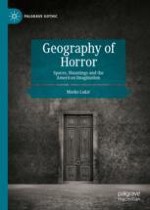Abstract
While the highly creative and imaginative environment that characterized the American romantic period found a variety of ways to express itself, ranging between dark cautionary tales, politically motivated fictions, all the way to the somewhat graphically exploitative rendering of contemporary criminal deeds, certain tropes nevertheless stood out and so assured their historical persistence and relevance. As evidenced and partially addressed in the previous chapter, the concept of the Frontier, together with all of its qualities and complexities, positions itself as a key geo-political element used in the process of defining the new identity of the continent, as well as a continuous reference point for the imagination of the entire nation. Although the genesis of the idea and concept of the Frontier developed spontaneously, imposing itself as a geographical and spatial reality whose harshness had to be conquered if the new continent and its wilderness were to be tamed and exploited, its metaphoric and symbolic value had to be evaluated and valorized separately. This theoretical, as well as philosophical, endeavor, was initiated by Frederic Jackson Turner, who in his lecture titled “The Significance of the Frontier in American History”, presented on July 12th, 1893 to the American Historical Association in Chicago, discussed the distinctions between the American frontier and its spatial counterparts in Europe, as well as the influence and symbolic value derived through the interaction and experiences of American frontiersmen. Turner, therefore, articulates his understanding of the European frontier(s) as “sharply distinguished” from the American one because they function as “a fortified boundary line running through dense populations” (2021, 2). Conversely, the American frontier is perceived as “the meeting point between savagery and civilization”, functioning as a “line of most rapid and effective Americanization” (2021, 2). This is the space where “[t]he wilderness masters the colonist” and forces this “European in dress, industries, tools, modes of travel, and thought” (2021, 2) to trade his railroad car for a birch canoe, remove his civilized garments and put on a hunting shirt and moccasins, live in a log cabin and quickly learn how to plant Indian corn by plowing the earth with a sharp stick, as well as to shout the war cry and take the scalp in orthodox Indian fashion (2021, 2). Therefore, the colonist is forced to deal with the overwhelming adversities thrust upon him, and after the realization that he is not strong enough to defeat them, he must learn to accept his condition and adapt by following Indian trails and customs (2021, 2). The image of the subdued colonist and later pioneer, whose desires and attempts to defeat what is metaphorically and physically preventing him from installing an immediate dominance over the new continent, together with the experience of the spatial “meeting point” between civilization and wilderness represent an experiential amalgam from which a dichotomy emerges. On the one hand, the idea of the Frontier becomes defined and perceived as a harsh physical and geographical reality, which clearly demarcates what is explored and civilized from the unknown and wild regions beyond it. On the other, the Frontier becomes subject to sensational understanding and reading, where the dangerous and often unforgiving realities, together with the individual experiences of such surroundings, go through the process of mythologization and subsequent weaving of a national tale of heroism and individuality. Turner continues by developing his arguments and descriptions around the slow process of expansion, followed by, as he states, the frontier of settlements that, through their advancements, carried with themselves individualism, democracy, and nationalism (2021, 8). The portrayed exploration and colonization, although complex and filled with challenges and hardships, remains a positive, if not even a utopian experience, resulting in the birth of a nation that successfully managed to capitalize on the endured trials by channeling the obtained knowledge into powerful traits such as acute individualism, stubbornness, restless energy, and several other qualities. Therefore, Turner’s essential contribution lies in the recognition of the correlation between a particular space and an ideological and clearly utopian projection of the nation’s desired identity. However, what Turner neglects to address is the inevitable violence that accompanied this expansion and the unavoidable scars that shaped the nation’s subconscious.
